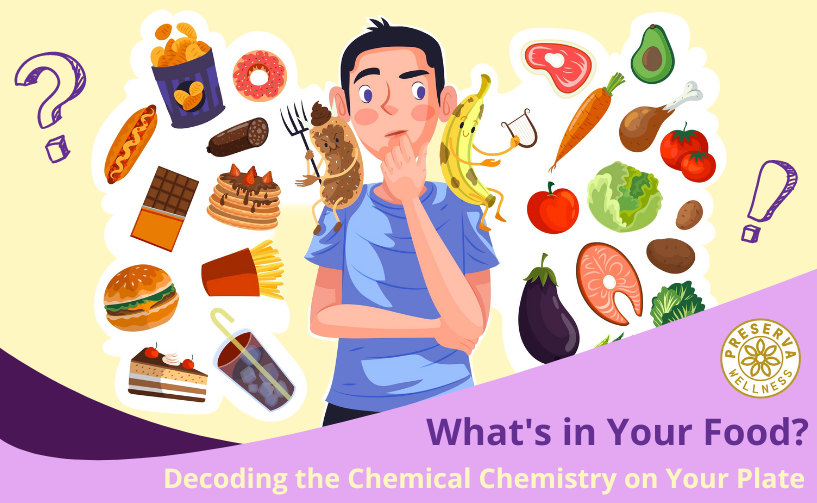In the vast landscape of packaged foods, navigating through the labyrinth of nutritional labels can be akin to detective work. We've all encountered those vigilant voices urging us to investigate every ingredient, warning against the likes of 'maltodextrin,' 'xanthan gum,' and mysterious E-numbers. As one who has turned label-reading into a full-blown detective hobby, my food philosophy aligns with the belief that if you can't pronounce it, perhaps you shouldn't be eating it. Eating natural and avoiding artificial additives is at the core of my approach.
Now, I understand that this stance is debatable. Are these additives really as bad as some make them out to be? Haven't regulatory agencies approved them? Does it even matter if consumed in small amounts? In this piece, I aim to shed light on why I consciously avoid 'chemicals' and 'additives' in my food and why you might want to consider it too, for the right reasons.
Beyond Bananas: Navigating the Chemical Kaleidoscope of Foods
Imagine a banana in your mind. It looks simple and pure, right? Now, picture it with a list of ingredients that seem like a magical potion created by an alchemist. This interesting idea comes from James Kennedy, a clever chemistry expert from Australia. It's a reminder that even foods we think of as completely natural are actually a mix of different chemicals.
For example, water, which has the chemical formula H2O, and glucose, represented by C6H12O6, are natural parts of the banana. So, when you eat a banana, you're enjoying a blend of various chemical compounds that work together to create the taste and texture you love.

Kennedy's message is simple yet powerful: natural foods, like bananas, have a mix of different components that might seem complex, but they're safe for us. The issue arises when we look at synthetic additives, like xanthan gum, found in many products. Although it thickens things, studies suggest it could upset the balance of our gut microbiome, which is crucial for our overall health. The concern isn't just about avoiding 'chemicals' but about these additives being unfamiliar to our bodies, leading us to question their long-term effects on our health.
Understanding Food Approvals: The Maze of Regulations
The oft-repeated reassurance that food additives undergo a rigorous inspection by regulatory bodies, such as the FDA or FSSAI, conceals a complicated reality. The GRAS (Generally Recognised As Safe) category, initially conceived for straightforward items like vinegar or salt, reveals its inherent pitfalls. For instance, there was a mistake where the molecular structure of Corn Oil ONE got mixed up with an HIV drug, raising doubts about how accurately safety is assessed.
Additionally, the differences in rules, as seen in the contrasting views on titanium dioxide (E171) between the EU and the US, highlight uncertainties and inconsistencies in safety standards for food additives. The precautionary principle, favouring caution when things are unclear, becomes an essential guide in navigating the complex realm of food additive safety and approval.

The Culinary Alchemy: Decoding the Economics Behind Additives
Looking into why additives are added to highly processed foods reveals an economic motive. Take ice cream, for example. While it may seem delicious, it actually contains various additives like emulsifiers and gums. These additives do more than just improve texture; they also help cut down on production expenses.
Dive into the world of molecular mimicry, a clever technique where chemically created substances copy the qualities of natural ingredients. This allows for making ice cream that tastes and feels just as good as traditional ones but costs way less. This cost-effective approach isn't just limited to ice cream; it spreads to many processed foods. Additives help these foods last longer on the shelf, simplify distribution, and sometimes lead to overeating.
In simple terms, the widespread use of additives in processed foods goes beyond improving taste or texture. It's a business strategy that prioritises saving money, even if it means compromising the natural quality of the food.

The Heart of the Matter
As concerned and knowledgeable consumers, we possess the ability to shape and influence the food industry by making informed and mindful choices. Choosing foods that contain simple, natural and easy-to-understand ingredients is not only about the food we consume but also about the kind of food culture and world we aspire to create.
To achieve this, we need to start paying attention to the labels on the products we buy. The next time you find yourself tempted to purchase something, take a moment to read and understand the label. If it's filled with obscure and complicated chemical names, it may be better to leave it on the shelf.
As a collective, we can push for clearer labels and simpler, less processed options. This way, we can begin to build a healthier food culture, one label at a time. By advocating for transparency and understanding in the food industry, we can create a world where healthier food choices are readily available and easy to make. Let's work together to create this better food culture for ourselves and future generations.






